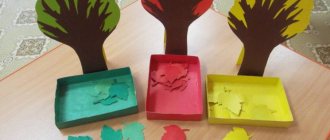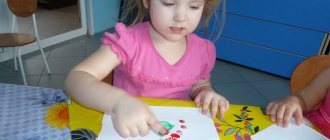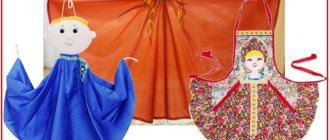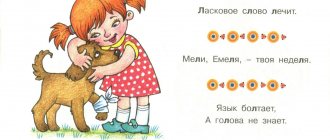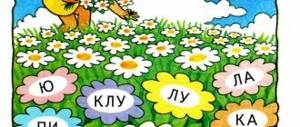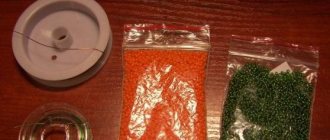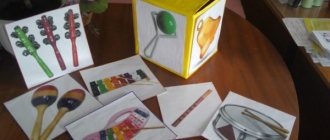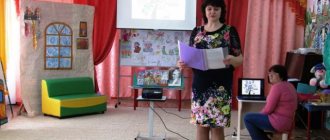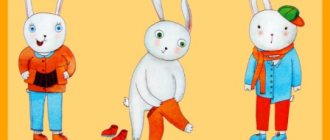Classification of didactic games
There is no unified classification in Russian pedagogy, since it is customary to separate them according to different criteria. There are several types of association.
By use of material:
- desktop-printed - “walkers”, cut-out pictures, lotto, dominoes;
- with objects - natural materials, mosaics, folk toys;
- verbal - “Colors”, “Riddles”.
According to the content of training and education:
- on the formation of mathematical concepts;
- sensory;
- verbal;
- to get acquainted with nature;
- other games that carry certain educational and educational objectives.
By type of activity:
- conversations;
- trips;
- puzzles;
- instructions;
- assumptions.
Structure of the didactic game
Didactic games for primary schoolchildren, preschoolers and young children differ in complexity, but have a single structure.
The structure accommodates:
- didactic task;
- game task;
- game actions;
- game rules;
- game result.
Didactic task
Didactic tasks are realized during the game, determined in advance by adults who plan and manage it.
Game task
It reflects the actions of children during the lesson, given in the form of an installation that encourages participants to be cognitively active.
Game actions
The game is impossible without active actions, and their complexity depends on the age of the children. Younger preschoolers have access to 1-2 actions, older ones - 4-5.
Game rules
So that the children do not lose interest in the game process, it should not be overloaded with rules. But you can’t live without them either. Rules help children interact, maintain discipline, and learn proper play behavior.
Game result
This part reflects the achievement of the learning goal. Unlike ordinary games, didactic games cannot be content with just winning, but must contribute to the acquisition of knowledge and the development of the child’s mental activity.
DIY didactic games for speech development for children 4-7 years old
DIY didactic games
on speech development for children 4-7 years old
Didactic game "Seasons"
This game is intended for use with children aged 3 to 7 years.
Purpose of the game:
to help clarify and expand preschoolers’ ideas about the seasons, seasonal changes occurring in living and inanimate nature, the development of connected speech, and cultivate interest in cognitive and play activities. Each age group has its own version of the game.
Didactic game «
Seasons
"
has a developing, educational and educational meaning. It can be used in almost any type of children's activity. This game is perfect for individual, subgroup and frontal work with preschoolers.
Material:
4 pictures depicting the seasons, and cut cards with signs of the seasons.
The game must be preceded by a conversation.
For example:
In winter the days are short. The sun is low and warms weakly. Snow falls. Cold. People wear winter clothes. In winter we celebrate everyone's favorite holiday - New Year.
In spring, the days become longer. The sun is warming better. It is getting warmer. Snow is melting. Streams are flowing. Leaves appear on the trees. Grass begins to grow. Flowers are blooming. Migratory birds arrive. People wear demi-season clothes. In the spring we celebrate everyone’s favorite holiday - March 8th
In summer the sun is high, shines brightly, and warms well. The weather is hot. Flowers bloom and berries appear. People wear summer clothes. You can swim in natural reservoirs and sunbathe.
In autumn, the days become shorter and shorter. The sun is lower. It's getting cooler. The vegetable harvest is ripe. Leaves are falling from the trees. Migratory birds fly south. It rains often. People wear warm clothes. The most famous autumn holiday is the Day of Knowledge.
Game task
is to put cards with signs of the season in the windows of the corresponding card and explain your choice.
Rules of the game:
Large cards are given to the participants of the game. Small cards are laid out on the table. Children take turns taking one card at a time and see if this card is suitable for a large card, if there is such a sign for this time of year. If not, the small card must be placed back on the table. The first one to close all the windows wins. The game can be used both in classes and in children’s free independent activities.
Each age group has its own version of the game.
Didactic game
“Cleaning the room: put it on the shelves”
Purpose of the game:
promote the development of logical thinking, memory, speech, the ability to generalize and justify.
Didactic task:
Exercise children in classifying objects. The child is required to find a group of similar objects, primarily by purpose, and arrange them on the right shelves.
Materials:
a box in the shape of a cabinet with shelves and cut cards with objects.
Progress of the game:
We lay out cards with drawn objects in disarray on the table. We invite the child to do the cleaning. You need to arrange items on shelves according to their purpose and name the group (clothing, dishes, toys, shoes, household chemicals, medical supplies).
Didactic
game
“Carlson Away”
The goal of the game:
consolidating the use of relative adjectives and the method of their formation in children’s speech, activating the vocabulary of adjectives.
Materials:
A large card with Carlson and the Kid and small cards with images of treats (jam, sweets, juice).
Progress of the game:
Children take turns taking small cards and calling out the treats.
For example:
Imagine that Carlson came to visit us. He has a great sweet tooth, and we need to treat him with something tasty.
What can we treat Carlson to? Jam! What kind of jam? Banana (orange, strawberry, etc. - put the desired card). What else can we treat Carlson to? Sweetie! What kind of candy? Banana (orange, strawberry, etc.). ... Juice. Banana, orange, strawberry juice.
Didactic
game
“My, my, mine, mine”
Target:
exercise children in classification, correlating nouns of masculine, feminine, neuter gender; enriching the vocabulary by selecting words; teaching children to agree nouns with possessive pronouns my, mine, mine, mine.
Rules of the game
consist in the correct selection by participants of cards with images of characters and objects, the name and names of which must be ordered in accordance with masculine, feminine, neuter genders.
Materials:
Large cards of four and small cards with objects
The cards depict a Hedgehog with an apple and small cards depicting objects
Progress of the game:
Cards are placed on a special field, separate for each type. After finishing sorting the cards by gender, the children must explain their choice. Children are invited to put pictures on the apple windows called “Mine, mine, mine, mine.”
Be sure to say at the same time, for example: “my fish.”
Didactic
game
“He, she, they, it”
Target:
exercise children in classification, correlating nouns of masculine, feminine, neuter gender; enriching the vocabulary by selecting words; teaching children to agree nouns with pronouns he, she, they; and also to develop in children the ability to distinguish the gender of possessive pronouns mine, mine, mine.
Rules of the game
consist in the correct selection by participants of cards with images of characters and objects, the name and names of which must be ordered in accordance with masculine, feminine, neuter genders
Children are invited to arrange the pictures into houses called “He”, “She”, “They”. The child puts pictures about which one can say “my” in the house called “He”, pictures about which one can say “mine” - in the house “She”, “mine” - “It”.
Didactic game
"Sound Clock"
(how the words differ).
This didactic game will help you figure it out and understand that one single letter can change the meaning of an entire word.
This game is perfect for individual, subgroup and frontal work with preschoolers
Each age group has its own version of the game.
Target:
consolidate, clarify and activate children’s knowledge about the spoken word
And thunderous material:
large size “Sound Clock” manual and cards with objects.
Option 1. (for children 4-5 years old)
Rules of the game:
1.Say the names of the objects depicted.
2. Find two word names that sound similar and point to them with the hands of a clock.
3. Find two words - names that are not similar in sound and point to them with the hands of a clock.
4. Find two short words, indicate with arrows, and vice versa - two long words.
5. Find two word names that begin with the same sound.
Option 2. (for children 4-7 years old)
Rules of the game:
1. Select and name the first and last sound in the names of the pictures.
2.Name first those pictures that begin with voiced consonants, then with voiceless ones.
3. Determine what is the first and last sound in the name of the picture: hard or soft consonant, vowel.
4.Choose words that begin with the same sound as the name of the picture pointed to by the small arrow.
5. Find words ending with the same sounds as the name of the picture, which is pointed to by the small hand of the clock.
6. Come up with phrases consisting of two, three and four words, be sure to include the names of those pictures that the small hand of the clock points to.
Didactic game
“Guess the word”
(puzzles for preschoolers)
Read by first letters is a very fun and entertaining game for children aged 5-6 years, which also develops reading skills. These are the simplest puzzles. The game develops memory, attention, logical thinking, phonemic hearing. The game reinforces the ability to identify the first sound in a word and write it using a letter, reading skills, and sound-letter analysis. Target:
to train children in identifying the first sound in words and composing words, to promote the development of phonemic hearing.
Game material:
cards with pictures, a set of letters and symbols (blue, green and red squares)
Didactic task:
Having identified the first sound in the name of each picture, guess the word and read it (lay out the word with symbols and letters)
Progress of the game:
Children solve the word by identifying the first sound and lay out the word using symbols and letters.
Didactic game
"Treat the animals"
Target
:
practice dividing words into syllables, finding long and short words (forming an idea of the syllabic composition of a word).
And thunderous material:
Three large cards depicting a spruce, a birch and a bush, cards with pictures
.
Progress of the game:
The teacher suggests:
1. put words-delicacies for forest dwellers under a bush, fir tree and birch. Under the bush you need to put words consisting of one syllable, under the Christmas tree words consisting of two syllables, but under the birch tree words - of three syllables.
To do this, you need to determine the number of syllables (parts) in a word.
Children:
Apple. The word apple has three syllables. The first syllable is YAB. I will put it under a birch tree (you can clap the word).
2.Name the shortest word. Find the longest word
Didactic game
"Syllable watch"
This is an interesting, entertaining game for children 5-7 years old that develops reading skills. The game develops memory, attention, logical thinking, phonemic hearing. The game reinforces the ability to identify syllables in a word and contributes to the development of sound-letter analysis of the word.
Target:
practice composing words from syllables;
Game material:
manual "Syllabic clock"
Rules of the game:
Using syllables, game participants form words that are encrypted in the manual and place arrows on them (you need to add another syllable to one syllable, so we get a word).
Syllables: KO-PA - RA -SA -TY - LA - FOR - LI
As a result, we get the words :
fox, Lisa, linden, goat, bark, braid, cats, couple, Lara
Didactic game
"Magic Circle"
Target:
exercise in identifying the first sound in a word, promote the development of phonemic awareness. Continue to expand children's vocabulary through the use of qualitative, possessive and complex adjectives. Continue to practice the formation of different degrees of comparison of adjectives, adverbs and the use of nouns in the instrumental case.
Game material:
manual "Magic Circle"
Rules of the game:
The tool consists of four rotating wheels. On the first circle there are cubs. on the second - the mothers of the cubs, on the third - the house (dwellings), - on the fourth - parts of the animal’s body: tails, paws, fur.
Children spin the wheel and find the mothers their cubs, a home, identify parts of the animal’s body, and thus answer questions :
Who with whom? Where live? Whose House? What part of the body is this? Whose tail? Whose paws?
Children's answers:
A little fox and a fox live in a hole. Fox hole, fox tail
IN:-
And if a fox has a long tail, does that mean what kind of fox is it? - long-tailed
IN:-
And if a hare has a short tail, what kind of hare does it mean? - short-tailed
IN:-
The wolf's tail is long, and the fox's tail is even……longer, more…. long
IN:-
The bear has a tail…..small, and the bunny has an even….smaller tail.
Tasks and functions
All types of didactic games for preschoolers and schoolchildren are united by common objectives:
- Educational. Forms new knowledge, abilities, skills in children, and also consolidates them. Develops cognitive processes, broadens horizons;
- Educational. Influences the child's personality;
- Orientation. Teaches you to understand the situation, using the acquired knowledge in the future;
- Motivational and incentive. Helps to activate children's activities associated with involuntary cognitive interest.
Didactics - the science of learning
A good way out of the situation is educational games. Psychologists and teachers established back in the middle of the last century that the skills and knowledge gained through an exciting game are most firmly and sustainably acquired.
In addition, it is easier to persuade a child to repeat the same game than to repeat the same lessons. And repetition, as we know, is the mother of learning.
Such educational games are called didactic. Didactics is a science that studies the cognitive and teaching process itself.
Read here - Do-it-yourself mouse trap: types and options for the best models. 105 photo and video tips on how to make an effective mousetrap
The fascinating process of creating your future favorite toy is also a kind of useful educational game. All that remains is to decide which skills to develop first.
Features of didactic games
Didactic games for preschoolers in kindergarten are used in all their diversity. They take up most of the school time, and it happens that the entire lesson for preschoolers consists of several such games. Educators widely use tasks that stimulate several types of sensations - these are board and object games. The cyclical nature of such games is frequent, which is due to the age characteristics of preschoolers.
For children 7-10 years old, didactic tasks are somewhat modified. Word games come to the fore. The teacher, as a rule, uses this type of activity at the beginning or end of the lesson to interest younger students or to maintain interest in the material covered. A feature of primary school students is a well-developed imagination, the emergence of logical and analytical thinking, due to which educational games can become significantly more complex.
Didactic games article on the topic
The leading activity of preschool children is play. A didactic game is a verbose, complex, pedagogical phenomenon: it is a gaming method of teaching preschool children, a form of teaching children, an independent play activity, and a means of comprehensive education of a child. Didactic games contribute to: - the development of cognitive and mental abilities: acquiring new knowledge, its generalization and consolidation, expanding their existing ideas about objects and natural phenomena, plants, animals; development of memory, attention, observation; developing the ability to express one’s judgments and draw conclusions. — development of children’s speech: replenishment and activation of vocabulary. - social and moral development of a preschool child: in such a game, the knowledge of relationships between children, adults, objects of living and inanimate nature occurs, in it the child shows a sensitive attitude towards peers, learns to be fair, to give in if necessary, learns to sympathize, etc. . The structure of the didactic game is formed by basic and additional components. The main components include: didactic task, game actions, game rules, result and didactic material. Additional components: plot and role. Conducting didactic games includes: 1. Familiarizing children with the content of the game, using didactic material in it (showing objects, pictures, a short conversation, during which the children’s knowledge and ideas are clarified). 2.Explanation of the course and rules of the game, while strictly following these rules. 3. Showing game actions. 4. Defining the role of an adult in the game, his participation as a player, fan or referee (the teacher directs the actions of the players with advice, questions, reminders). 5. Summing up the game is a crucial moment in its management. Based on the results of the game, one can judge its effectiveness and whether it will be used by children in independent play activities. Analysis of the game allows us to identify individual abilities in the behavior and character of children. This means properly organizing individual work with them.
Education in the form of a didactic game is based on the child’s desire to enter an imaginary situation and act according to its laws, that is, it corresponds to the age characteristics of a preschooler.
Types of didactic games:
1. Games with objects (toys).
2. Printed board games.
3.Word games.
Didactic games - differ in educational content, cognitive activity of children, game actions and rules, organization and relationships of children, and the role of the teacher.
Games with objects are based on children’s direct perception and correspond to the child’s desire to act with objects and thus become familiar with them. In games with objects, children learn to compare, establish similarities and differences between objects. The value of these games is that with their help children become familiar with the properties of objects, size, and color. When introducing children to nature in such games, I use natural materials (plant seeds, leaves, pebbles, various flowers, pine cones, twigs, vegetables, fruits, etc. - which arouses keen interest and an active desire in children to play. Examples of such games: “Don’t make a mistake”, “Describe this object”, “What is this?”, “What first, what then”, etc. Board and printed games are an interesting activity for children when getting acquainted with the world around them, the world of animals and plants, living and inanimate nature. They are diverse in types: “lotto”, “dominoes”, paired pictures" With the help of board and printed games you can successfully develop speech skills, mathematical abilities, logic, attention, learn to model life patterns and make decisions, and develop self-control skills.
Word games are an effective method of fostering independent thinking and speech development in children. They are built on the words and actions of the players; children independently solve various mental problems: they describe objects, highlighting their characteristic features, guess them from the description, find similarities and differences between these objects and natural phenomena.
During the games, children clarify, consolidate, and expand their ideas about natural objects and its seasonal changes.
Didactic games - travel - are one of the effective ways to enhance the cognitive activity of children.
Didactic game in experimental activities - contributes to the formation of children's cognitive interest in the environment, develops basic mental processes, observation, and thinking.
The joint activities of parents and teachers - individual counseling of parents, information stands, moving folders, thematic exhibitions with the proposed material - gives a more effective result in working with children. To develop children’s knowledge about the world around them, systematize them, and cultivate a humane attitude towards nature, I use the following didactic games:
Material used:
Games with objects “What is this?” Goal: to clarify children’s ideas about inanimate objects. Material: natural - sand, stones, earth, water, snow. Progress of the game. Children are offered pictures and, depending on what is drawn on it, they need to arrange the natural material accordingly and answer what is it? And what is it? (Big, heavy, light, small, dry, wet, loose). What can you do with it? “Who eats what?” Target. Strengthen children's ideas about animal food. Progress of the game. Children take out from the bag: carrots, cabbage, raspberries, cones, grains, oats, etc. They name it and remember what animal eats this food. “Children on a branch” Purpose. To consolidate children's knowledge about the leaves and fruits of trees and shrubs, to teach them to select them according to their belonging to the same plant. Progress of the game. Children look at the leaves of trees and shrubs and name them. At the teacher’s suggestion: “Children, find your branches” - the children select the corresponding fruit for each leaf. This game can be played with dried leaves and fruits throughout the year. The children themselves can prepare the material for the game. “Find what I’ll show you” Didactic task. Find an item by similarity. Equipment. Place identical sets of vegetables and fruits on two trays. Cover one (for the teacher) with a napkin. Progress of the game. The teacher briefly shows one of the objects hidden under the napkin and removes it again, then asks the children: “Find the same one on another tray and remember what it’s called.” Children take turns completing the task until all the fruits and vegetables hidden under the napkin are named. “What comes first, what comes next?” Target. To consolidate children's knowledge about the development and growth of animals. Progress of the game. Children are presented with objects: an egg, a chicken, a model of a chicken; kitten, cat; puppy, dog. Children need to arrange these items in the correct order. Printed board games “When is this?” Target. Clarify children's ideas about seasonal phenomena in nature. Progress of the game. Each of the children has object pictures depicting snowfall, rain, a sunny day, cloudy weather, hail is falling, the wind is blowing, icicles are hanging, etc. and story pictures with images of different seasons. Children need to correctly arrange the pictures they have. "Magic Train" Goal. To consolidate and systematize children’s ideas about trees and shrubs. Material. Two trains cut out of cardboard (each train has 4 cars with 5 windows); two sets of cards with images of plants. Progress of the game: On the table in front of the children there is a “train” and cards with images of animals. Educator. In front of you is a train and passengers. They need to be placed in the carriages (in the first - bushes, in the second - flowers, etc.) so that one passenger is visible in each window. The first one to place the animals correctly in the carriages will be the winner. Similarly, this game can be played to consolidate ideas about various groups of plants (forests, gardens, meadows, vegetable gardens). “Four Pictures” Purpose. To consolidate children's ideas about the surrounding nature, to develop attention and observation skills. Progress of the game. The game consists of 24 pictures depicting birds, butterflies, and animals. The presenter shuffles the cards and distributes them equally to the game participants (from 3 to 6 people). Each player must pick up 4 cards that are identical in content. The player who begins the game, having examined his cards, passes one of them to the person sitting on the left. If he needs a card, he keeps it for himself, and any unnecessary one also passes on to the neighbor on the left, etc. Having picked up the cards, each player places them face down in front of them. When all possible sets have been selected, the game ends. Participants in the game turn over the collected cards and lay them out four at a time so that everyone can see them. The one with the most correctly selected cards wins. Verbal games “When does this happen?” Purpose. Clarify and deepen children's knowledge about the seasons. Progress of the game. The teacher reads alternately short texts in poetry or prose about the seasons, and the children guess. “Find something to tell me about” Didactic task. Find objects using the listed characteristics. Equipment. Vegetables and fruits are laid out along the edge of the table so that the distinctive features of the objects are clearly visible to all children. Progress of the game. The teacher describes in detail one of the objects lying on the table, that is, names the shape of vegetables and fruits, their color and taste. Then the teacher asks one of the children: “Show it on the table, and then name what I told you about.” If the child has completed the task, the teacher describes another object, and another child completes the task. The game continues until all children guess the item from the description.
“Guess who it is?” Target. Strengthen children's understanding of the characteristic features of wild and domestic animals. Progress of the game. The teacher describes the animal (its appearance, habits, habitat...) the children must guess who they are talking about. “When does this happen?” Target. Clarify children's ideas about seasonal phenomena. Progress of the game. Children are offered leaves of different plants with different colors, cones, a herbarium of flowering plants, etc. depending on the time of year. Children need to name the time of year when there are such leaves, branches, flowers. Outdoor games “What do we take in the basket” Purpose: to consolidate in children the knowledge of what crops are harvested in the field, in the garden, in the vegetable garden, in the forest. Learn to distinguish fruits based on where they are grown. To form an idea of the role of people in conservation of nature. Materials: Medallions with images of vegetables, fruits, cereals, melons, mushrooms, berries, as well as baskets. Progress of the game. Some children have medallions depicting various gifts of nature. Others have medallions in the form of baskets. Children - fruits, disperse around the room to cheerful music, with movements and facial expressions they depict a clumsy watermelon, tender strawberries, a mushroom hiding in the grass, etc. Children - baskets must pick up fruits in both hands. Necessary condition: each child must bring fruits that grow in one place (vegetables from the garden, etc.). The one who fulfills this condition wins. The tops are the roots Did. task: teach children to make a whole from parts. Materials: two hoops, pictures of vegetables. Game progress: option 1. Take two hoops: red, blue. Place them so that the hoops intersect. In the red hoop you need to put vegetables whose roots are used for food, and in the blue hoop you need to put those whose tops are used. The child comes to the table, chooses a vegetable, shows it to the children and puts it in the right circle, explaining why he put the vegetable there. (in the area where the hoops intersect there should be vegetables whose tops and roots are used: onions, parsley, etc. Option 2. On the table are the tops and roots of plants - vegetables. Children are divided into two groups: tops and roots. Children The first group takes the tops, the second - the roots. At the signal, everyone runs in all directions. At the signal “One, two, three - find your pair!”, you need to Play with the ball “Air, earth, water” Educational task: to consolidate children’s knowledge about objects nature. Develop auditory attention, thinking, intelligence. Materials: ball. Progress of the game: Option 1. The teacher throws the ball to the child and names an object of nature, for example, “magpie.” The child must answer “air” and throw the ball back. To the word “dolphin” the child answers “water”, to the word “wolf” - “earth”, etc. Option 2. The teacher calls the word “air”, the child who caught the ball must name the bird. To the word “earth” - an animal that lives on earth; to the word “water” - the inhabitant of rivers, seas, lakes and oceans. Nature and man. Didactic task: to consolidate and systematize children’s knowledge about what is created by man and what nature gives to man. Materials: ball. Progress of the game: the teacher conducts a conversation with the children, during which he clarifies their knowledge that the objects around us are either made by human hands or exist in nature, and people use them; for example, forests, coal, oil, gas exist in nature, but houses and factories are created by humans. "What is made by man"? asks the teacher and throws the ball. “What is created by nature”? asks the teacher and throws the ball. Children catch the ball and answer the question. Those who cannot remember miss their turn. Choose the one you need. Did. task: to consolidate knowledge about nature. Develop thinking and cognitive activity. Materials: subject pictures. Progress of the game: object pictures are scattered on the table. The teacher names some property or sign, and the children must choose as many objects as possible that have this property. For example: “green” - these can be pictures of a leaf, cucumber, cabbage, grasshopper. Or: “wet” - water, dew, cloud, fog, frost, etc. Where are the snowflakes? Did. task: to consolidate knowledge about the various states of water. Develop memory and cognitive activity. Materials: cards depicting different states of water: waterfall, river, puddle, ice, snowfall, cloud, rain, steam, snowflake, etc. Game progress: option 1. Children dance in a circle around cards laid out in a circle. The cards depict different states of water: waterfall, river, puddle, ice, snowfall, cloud, rain, steam, snowflake, etc. While moving in a circle, the words are said: Summer has come. The sun shone brighter. It's getting hotter, where should we look for a snowflake? With the last word everyone stops. Those in front of whom the required pictures are located must raise them and explain their choice. The movement continues with the words: Finally, winter has come: Cold, blizzard, cold. Go out for a walk. Where should we look for a snowflake? The desired pictures are selected again and the choice is explained. Option 2. There are 4 hoops depicting the four seasons. Children must distribute their cards to the hoops, explaining their choice. Some cards may correspond to several seasons. The conclusion is drawn from the answers to the questions: - At what time of year can water in nature be in a solid state? (Winter, early spring, late autumn). The birds arrived. Did. task: to clarify the idea of birds. Progress of the game: the teacher names only the birds, but if he suddenly makes a mistake, then the children must stomp or clap. For example. Birds arrived: pigeons, tits, flies and swifts. Children stomp – What’s wrong? (flies) - Who are these flies? (insects) - Birds arrived: pigeons, tits, storks, crows, jackdaws, macaroni. The children are stomping. - birds arrived: pigeons, martens... Children stomp. Game continues. Birds arrived: Tit pigeons, Jackdaws and swifts, Lapwings, swifts, Storks, cuckoos, Even scops owls, Swans, starlings. Well done to all of you. Result: the teacher, together with the children, identifies migratory and wintering birds. When does this happen? Did. task: to teach children to distinguish the signs of the seasons. With the help of poetic words, show the beauty of different seasons, the diversity of seasonal phenomena and people's activities. Materials: for each child, pictures with landscapes of spring, summer, autumn and winter. Progress of the game: the teacher reads a poem, and the children show a picture depicting the season mentioned in the poem. Spring. In the clearing, blades of grass appear near the path. A stream runs from a hillock, and there is snow under the tree. Summer. Our quiet river is both bright and wide. Let's run to swim and splash with the fish... Autumn. The grass in the meadows withers and turns yellow, Only the winter leaves turn green in the fields. A cloud covers the sky, the sun does not shine, the wind howls in the field, the rain drizzles. Winter. Under blue skies, Magnificent carpets, Glistening in the sun, the snow lies; The transparent forest alone turns black, And the spruce turns green through the frost, And the river glitters under the ice. Did. task: to clarify children’s knowledge about the flowering time of individual plants (for example, daffodil, tulip - in spring); golden ball, asters - in autumn, etc.; teach them to classify on this basis, develop their memory and intelligence. Materials: ball. Progress of the game: children stand in a circle. The teacher or child throws the ball, naming the time of year when the plant grows: spring, summer, autumn. The child names the plant. What is made of what? Did. task: to teach children to identify the material from which an object is made. Materials: wooden cube, aluminum bowl, glass jar, metal bell, key, etc. Progress of the game: children take out different objects from the bag and name them, indicating what each object is made of. Guess - ka. Did. task: to develop children’s ability to solve riddles, to correlate a verbal image with the image in the picture; clarify children's knowledge about berries. Materials: pictures for each child with images of berries. Book of riddles.
Progress of the game: on the table in front of each child there are pictures of the answer. The teacher makes a riddle, the children look for and pick up the answer picture. Edible - inedible. Did. task: to consolidate knowledge about edible and inedible mushrooms. Materials: basket, object pictures with images of edible and inedible mushrooms. Progress of the game: on the table in front of each child there are pictures of the answer. The teacher makes a riddle about mushrooms, the children look for and put a picture of the answer to an edible mushroom in baskets. Arrange the planets correctly. Did. task: to consolidate knowledge about the main planets. Materials: belt with sewn rays - ribbons of different lengths (9 pieces). Caps with images of planets. It’s so hot on this planet that it’s dangerous to be there, friends.
-What is our hottest planet, where is it located? (Mercury because it is closest to the sun). And this planet was shackled by a terrible cold, the sun’s rays did not reach it with warmth. -What kind of planet is this? (Pluto, because it is farthest from the sun and the smallest of all the planets). The child in the Pluto hat takes the longest ribbon No. 9. And this planet is dear to us all. The planet gave us life... (all: Earth) -In what orbit does planet Earth rotate? Where is our planet from the sun? (On the 3rd). A child in an “Earth” cap takes hold of ribbon No. 3. Two planets are close to planet Earth. My friend, name them quickly. (Venus and Mars). Children wearing “Venus” and “Mars” hats occupy the 2nd and 4th orbits, respectively. And this planet is proud of itself because it is considered the largest. -What kind of planet is this? What orbit is it in? (Jupiter, orbit No. 5). The child in the Jupiter cap takes place No. 5. The planet is surrounded by rings, and this makes it different from everyone else. (Saturn) Child - “Saturn” occupies orbit No. 6. What kind of green planets are they? (Uranus) A child wearing a matching Neptune cap occupies orbit #8. All the children took their places and began to revolve around the “Sun”. The round dance of the planets is spinning. Each has its own size and color. For each, the path is defined. But only on Earth is the world populated with life. Useful - not useful. Did. task: to consolidate the concepts of healthy and harmful products. Materials: cards with images of products. How to play: Place what is useful on one table, and what is not useful on the other. Healthy: rolled oats, kefir, onions, carrots, apples, cabbage, sunflower oil, pears, etc. Unhealthy: chips, fatty meats, chocolates, cakes, Fanta, etc.
Educational games for children
Recently, a child psychologist has increasingly had to deal with a somewhat strange phenomenon - some preschoolers, when asked to draw what they love, write letters and numbers instead of the plot drawing expected from them. Why is this happening?
Obviously, on the one hand, the child assumes that this demonstration of his abilities and intelligence will cause a positive reaction from adults, but, on the other hand, it is often much easier for him, if the skills have been developed, to draw sticks, circles, numbers and letters, since this does not require flights of fancy and emotional dedication.
It’s a pity that this happens precisely in the period from 4 to 7 years, during which children’s creativity flourishes, a kind of “renaissance” that also has its own natural ending. The uniqueness and irreversibility of this period are associated with the peculiarities of the child’s thinking, when in this age period his lack of a clear understanding of the boundary between fiction and reality is the norm.
In our desire to raise early “child prodigies” and in the pursuit of quick and imaginary success, we are missing something no less important than the encyclopedic knowledge that many parents strive to invest in their children. Sometimes I even had to console parents who complained that their child, who “used to be the best student in school, suddenly rebelled against studying at the university” or “was the best in mathematics in his class, and now strums the guitar and hears nothing else.” doesn't want to." The roots of this rebellion must be sought in early childhood, when the foundations of the child’s personality are laid. It is very important to provide the child with as many opportunities as possible for independent observation and exploration of the world around him, using a wide variety of educational games for children. Games are very important for the formation and development of a child’s personality, since they are not only tools for his self-expression, but also a way of understanding the world around him and adapting to it. For children, play is when the boundaries between fantasy and reality are blurred, when you can easily turn into the fearless Batman or Schwarzenegger or suddenly turn out to be a little goat, sometimes even test yourself in the role of a mother or father making very important decisions.
Play is an experience that a child acquires to think and speak freely, without fear of criticism for possible mistakes. This new experience contributes to his understanding of the relationships between norms and values accepted in society, as well as to increased self-esteem and the development of his own ego.
The game allows the child to better understand himself, as he breaks conventions and allows him to test himself in different roles - “strong-weak”, “beautiful-ugly”, “brave-cowardly”.
The game teaches children to communicate and understand other people.
Play is a dialogue between the child’s inner world and the outer world. In games, children learn the concepts of “right-wrong”, “can-do-not”, “inside me-outside me” and others.
It is very important that negative emotions, tensions and fears, which in normal communication the child suppresses or is embarrassed to express, are released, as a rule, in a play situation. Therefore, the game is a powerful and reliable psychotherapeutic tool. There is no need to interfere with children playing hide-and-seek, catch-up, classes, jump ropes; dolls, cars and other toys.
If you want to make friends with your own child, play with him, and also help him organize a game with other children. Any task can be turned into a game, even picking up toys. For example, you can tell your child: “Our ship is setting off on a long voyage. I ask the team to put all things in their places.”
Any request can be wrapped in a riddle: “Please bring me the first thing that enters the house (the key).” The value of educational children's games is that they quickly and effectively allow you to achieve the desired results without tiring the child and his parents.
What are educational games?
Educational games are games specially designed to activate the child’s various abilities, including motor and mental.
One of the main ways of learning about the world, which is also a child’s need, is play. During the game, new things are learned more easily and naturally. Using specially developed gaming techniques, you can promote the development of the senses - vision, hearing, mental abilities, strengthen attention and memory, help the child master motor skills and give impetus to faster development of speech.
Ordinary games keep the child occupied and entertained, while developmental games help to spend time not only interestingly, but also effectively, while receiving enormous benefits for overall development. That cognitive motive, which can be inconspicuously veiled in the game, will ultimately prepare the child for more serious steps of the future: study, communication, understanding and simply for a full-fledged adult life.
For each child’s age, a different game can be selected that develops exactly what is needed at the moment. Infants need games that develop the senses, motor skills, gross and fine motor skills, as well as exercises for speech development. Older children are offered games that are more complex and focus on developing mental qualities.
A large number of special games have been developed by teachers and psychologists for children with disabilities and developmental problems.
About teaching a child oral speech skills
There is often a misconception among some parents that if a child knows numbers and letter names and writes them a little, this means that he is ready for school. However, a child’s mastery of these skills and knowledge is not a self-sufficient condition and criterion of his readiness for school. Experience and practice of teaching at school show that with normal general development, any child, systematically attending school, can master this knowledge and skills in an extremely short time.
Sometimes a child psychologist hears complaints from parents of 6-year-old children that, despite intensive home activities with the child, or classes in special clubs to prepare the child for school, some children still do not master reading and arithmetic by the time classes begin. .
In addition to knowing numbers and letters, there is something more important that parents sometimes miss in their work to prepare their children for school. This is the child’s oral speech, the development of which is a necessary condition for his successful acquisition of written language (reading). The future student must have a sufficient vocabulary, be able to express thoughts grammatically and logically, memorize and read poetry, and also retell short texts. The degree of richness and grammatical correctness of a child’s oral speech determines his understanding of what he read, which is, as it were, a transformation of chains of visual symbols (letters) into chains of auditory stimuli (phonemes). Those. This means, as it were, voicing the text being read.
In other words, each child must have a sufficient level of development of coherent oral speech and thinking by the beginning of the first grade of school. What does the concept of “coherent oral speech” mean?
Coherent speech is a consistent and logically connected series of thoughts expressed in specific and precise words, connected into grammatically correct sentences. Without the help and guidance of an adult, coherent speech develops very slowly or does not develop at all, which is especially typical for children with various developmental disorders. When preparing their child for school, parents see their duty in teaching him coherent speech, letters and numbers, concepts of color and number, reading and counting. This is correct and absolutely normal. Painstaking activities are very important, but a variety of children's games, drawing, modeling and other types of children's creativity are also extremely necessary for the development of the child.
However, unnoticed by parents, the process of preparing a child for school sometimes turns into only an endless chain of questions and answers, completely occupying the child’s free time, depriving him of the opportunity to play and have fun and dulling his natural curiosity and initiative.
To avoid this and, at the same time, speed up and facilitate the process of the baby’s learning the necessary skills, his parents need to combine in their work on preparing the child three equally important and mutually related components - communication with the child, playing with him and his education. In this case, you can use both simple educational games known to all of us from childhood, as well as special teaching methods developed by psychologists. In order for your child to simultaneously enjoy these games and successfully master the skills necessary for his development, you and his parents will not need either a special room or absolute silence. All this can be done with the same, if not greater, success in a free and completely relaxed environment - on the seashore or lake, on the playground, while traveling on a bus or train.
To teach oral speech skills to children 5-6 years old, as a necessary condition for the development of reading (written) skills, we offer the parents of these children some educational games and methodological recommendations from a child psychologist. So, what should you play?
Games that develop a child’s oral speech
* Broken phone. Several participants in the game pass a word or short phrase to each other in a chain (whispering). The child always pays attention to the fact that the final word in the chain differs sharply from the original one and also to the fact that some words are very similar in sound and, therefore, can easily be distorted in meaning.
*What did it sound like? Together with your child, knock with a stick on the table, on the floor, on a plastic toy. Then blindfold the child with a scarf, knock on one of the named objects and ask him to guess which object you knocked on. So that your child can better practice this skill, periodically change roles with him.
* Name any words starting with a specific letter. For example, any words starting with the letter “B”: banana-balcony-storm-barrel-bull.
* Name more words on the topic. At a fast pace and within a minute, name as many words as possible that denote animals, birds, plants, materials, names of countries, etc. known to the child. In this game, the one who names the most words wins. The game promotes the development of flexibility of thinking and expands active vocabulary. * Name words that define a country, city, animal, plant, name and begin with the same letter. For example: Russia-Rostov-lynx-rice-Roman.
* Make a chain of words. So that the last letter of the previous word would also be the first of the subsequent one. For example: child-cow-aroma-cake-shadow.
* Make up chains of antonym words. For example: hot-cold, dark-light, tall-short, thin-fat, etc. * Name all known objects of the same color. For example: yellow - lemon, sun, sunflower, canary; or red - tomato, pepper, blood, etc. * Guess what I want to say. Say the first syllable of a word and ask your child to guess the entire word based on that syllable. Riddle and guess one by one. *Edible-inedible. Two players throw a ball to each other. The player throwing the ball names a word that means either an edible product or any inedible item. If a word is named that denotes an edible product, then the second player receiving the ball must catch it. If an inedible object is named, then there is no need to catch the ball.
* Mastering the concepts of the location of objects in space (inside, above, below, below, above, between, left, right). For example: invite your child to take a pencil and put it between the computer and the book, or on the third shelf in the right row, or to the right of the TV, etc.
Some recommendations from a child psychologist to parents on the development of a child’s oral speech
* Pay attention to how coherently, logically and grammatically correct the child expresses his thoughts. * Help the child describe objects, events and phenomena in as much detail as possible. At the same time, the boundaries of the child’s knowledge expand and his speech is enriched. * Start a notebook in which the child’s short stories will be written down in block letters and legibly, literally observing his style and words. Experience shows that a child perceives both aurally and visually much easier and faster the text that was written down exactly from his words. And this is natural, since at the same time he relies on his own speech skills and his vocabulary. * After the child has mastered basic reading skills, invite him to read his own works.
* When learning poems and songs, the child should not create the appearance of “singing”, not understanding the meaning of the words and inarticulately pronouncing some syllables. We need to help him, especially in songs, to correctly understand and pronounce every word. Therefore, sing along with him.
* Teach your child to find and come up with rhymes. For example: juice-sock; jackdaw stick; horn-pie; well done cucumber; porridge-Masha. * More often use and encourage children to use sayings, proverbs and common expressions.
* Teach your child to invent and make riddles. * Learn to tell jokes, understand humor and come up with funny stories.
Conditions
- Before the start of the game, the teacher plans this activity, sets educational, training and educational tasks.
- During the entire process, the adult remains in charge. He starts the game, clearly explains the rules, follows the unfolding of the plot and sums up the conclusion.
- The teacher takes an active part: he reacts emotionally to moments of the game, and helps the children if necessary.
- He takes into account the individual characteristics of children, changing the course or rules if necessary. Controls the rotation of game roles after the end of each game cycle.
Games in childhood, including didactic ones, are the leading type of human activity and are of great importance for him. Teachers and parents, by correctly implementing them, are able to help children develop and learn unnoticed and natural for their age.
